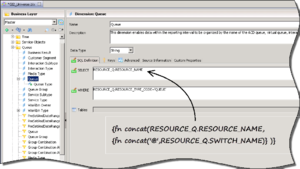Distinguishing Same-Named Queues
This page describes steps you can take to reset dimensions to distinguish queues with matching names. GI2 expects contact center objects to be uniquely named, and while this is usually true in single-switch environments, it might not be true in more complex environments that employ more than one switch. In such scenarios, the names of queue objects could be identical from one switch to the next.
Because the contact center objects in your enterprise might not have unique names, the queue-based GI2 reports consider only a queue’s name when retrieving data about queue objects. The reports do not filter data based on the switch from which the data originated, so queue-based GI2 reports display the results for all queue objects sharing the same name instead of only the results from the intended queue.
To reset the definition of queue dimensions to recognize the queue’s switch:
[+] Show Steps
- Open the GI2 Universe.
- In the definitions of all Queue dimensions, wherever they occur, replace the SELECT statement with the following:
{fn concat(RESOURCE_Q.RESOURCE_NAME,
{fn concat('@',RESOURCE_Q.SWITCH_NAME)}
)}
- Make similar modifications in other queue-type dimensions, such as Last Queue, Source Last Queue, and Target Last Queue.
- Save the universe and test the results.
- Export the universe back to the repository.
Queue-based reports now display the name of the queue’s switch along with the name of the queue object instead of displaying only the queue’s name. However, in some cases the queue@switch values might be too long to fit within the report headers, labels, and table cells where they might occur. The Interaction Flow Report, for instance, populates the names of queue objects in tables cells under the Source and Target columns of the report. You can adjust the layout of this and other reports for better presentation.

